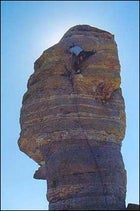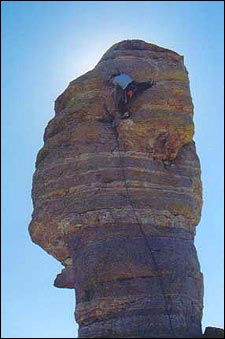 Santa’s little climber: one move from the top on Hitchcock Pinnacle at Arizona’s Mount Lemmon.
Santa’s little climber: one move from the top on Hitchcock Pinnacle at Arizona’s Mount Lemmon. Q: A few of us from Virginia want to take a rock-climbing trip somewhere warm during the Christmas holidays. We’re considering Red Rocks in Nevada and California’s Joshua Tree National Park, among other spots. Will it be warm enough at Red Rocks this time of year? Is Joshua Tree really just single pitch climbing, as we’ve heard? We’re after multi-pitch trad climbing somewhere in the 5.6 through 5.8 range. Thanks!
— Gloria Rose
Richmond, Virginia
���ϳԹ��� Advisor:
A: The hunt for warm winter climbing is one of those quests on which just about any serious fan of the vertiginous world must embark at some point. If you’ve got some time to kill your best bet is indeed to head to the deserts out west, where you’ll find fantastic multi-pitch trad climbing, some of it on cliffs that grow much too hot in the summer to scale.
No matter where you go, “warm” and “winter” aren’t ever going to be the best of partners unless you’re heading to the Caribbean. That said, the desert can be surprisingly pleasant during the day, with temperatures wriggling up into the 60s. But nights will always be cold. Really cold. As in the kind of cold that makes Virginia winters look like Barbados. Pack a down jacket, and be prepared for wind and sudden drops in temperatures no matter how balmy the day starts out. There’s nothing more miserable than being caught in a sudden freezing wind on pitch four of a six-pitch climb in your T-shirt. Take our word for it. You’re right about Joshua Tree having mostly one-pitch routes, and if you’re not a steely climber, the notoriously spooky runouts on slabby desert granite can be intimidating. Red Rock Canyon National Conservation Area () about 20 miles west of downtown Las Vegas is a little more forgiving, and it’s certainly popular on the winter climbing circuit. Christmas can indeed be warm, especially on south-facing climbs like Solar Slab, a 13-pitch 5.6. Other classic but easy trad routes, such as the five-pitch Cat in the Hat (5.6) and the nine-pitch Crimson Chrysalis (5.8+), number in the dozens, so you’d be hard pressed to be bored. Nights here are frigid and the only campground, a bleak expanse of scrub and sand called Thirteen-Mile Campground, offers no shelter from the winds that we’ve seen level tents à la Denali. (For more ���ϳԹ��� Advisor advice on visiting Red Rock Canyon, see ““.
Mount Lemmon just north of Tucson in Arizona’s Santa Catalina Mountains is another prime winter spot you ought to consider. There aren’t as many long trad routes, but days tend to be warmer here, especially down low. The Catalina Highway climbs for about 6,000 feet over 25 miles through the Coronado National Forest past hundreds of excellent routes, and the bulk of the granite and metamorphic crags lie on the mountain’s southern slopes. Obviously you’ll want to spend most of your time climbing down low (the top of Mount Lemmon actually has a ski area), but be sure to check out the Green Slabs, Windy Point (where you’ll find the stubby but mucho cool Hitchcock Pinnacle), and Chimney Rock. The campgrounds here are forested and pleasant, too. A couple of fires ripped through the area last summer, though rangers recently reopened some of the areas. Call the Santa Catalina Ranger District (; 520-749-8700) for more information.


